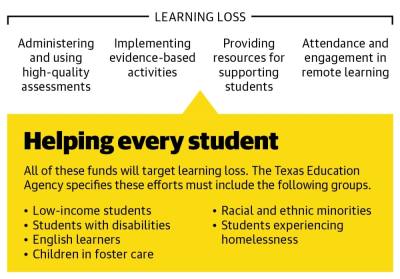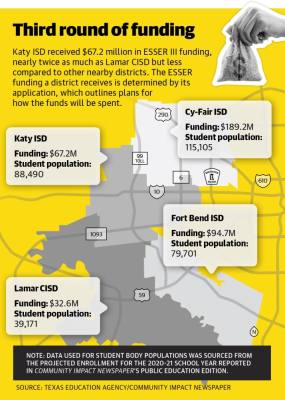Through a May district survey with more than 13,000 responses from parents, staff, students and members of the community, KISD established the community’s priorities for the federal funding, which directed a significant portion toward addressing learning loss and mental health through 2023.
The district was allocated $102.4 million in ESSER funding—not including the funds that will go toward the state’s hold-harmless policy, a pandemic-era guarantee that schools are not financially penalized for declines in attendance due to COVID-19. The Texas Education Agency requires the funds, which were distributed in spring 2020 and summer 2021, to go toward mental health, learning loss and safety.
“We have consistently addressed the safety and the well-being of our students and staff throughout the pandemic, so the majority of our funds will be spent in [mental health and learning loss],” KISD Chief Academic Officer Christine Caskey said about the funds at a June meeting.
The first round of ESSER funding brought $5.3 million to KISD, but the funding only supplanted state funding and was not considered “new funding,” according to a statement from KISD. ESSER II brought KISD $29.9 million, but a portion will also supplant state funds. ESSER III, which will only fund COVID-19-related items, allocated $67.2 million to KISD—$44 million of which was issued this summer with the remainder slated to come by spring 2022, according to district officials.
Despite the federal funding, statewide experts are still concerned about the lingering effects of the pandemic on education. KISD’s State of Texas Assessments of Academic Readiness in spring 2021 followed state trends with score decreases in nearly all subject areas compared spring of 2019, when the tests were last held.
Additionally, a report released by the American Psychological Association in July showed 81% of teens ages 13-17 have experienced more intense stress during the pandemic, leading to concerns about the mental health of students.
“[During the pandemic,] we are seeing a lot more self-injurious behaviors and depression, anxiety, social anxiety, opposition [and] defiance, and conflict within the family relationships,” said Alyssa Muchaw, a licensed professional counselor with Katy Child Psychology Associates. “Technology addictions, academic disengagement and disrupted sleeping patterns have also increased. ... All forms of anxiety seem to have increased. We’re seeing a significant amount of clients with depression and self-harming behavior.”
Learning loss
According to KISD’s community survey, 41% of respondents dubbed learning loss the highest priority for the ESSER funds.
Statewide STAAR results released in June showed a 4% decline in the percentage of Texas students reading at or above grade level and a 15% decline in students doing math at or above grade level compared to 2019. Statewide results also showed decreases in subjects such as social studies, biology and history.
A higher percentage of KISD students were approaching grade level in all subjects in both spring 2019 and spring 2021 when compared to the statewide average. Still, KISD STAAR results dipped slightly across most subject areas between the two years, results show.
Among the most notable declines in performance for KISD students was in seventh-grade math. In 2019, 81% of students were approaching grade level, but in 2021, that figure was 66%, according to the results.
The TEA outlined a list of allowable activities to which KISD could distribute the ESSER funds. The district outlined its plan for the funds, and KISD has budgeted for nearly $35 million to target learning loss specifically.
According to the district survey, 48% of respondents supported hiring additional academic intervention staff with the funds. TEA spokesperson Melissa Holmes said Texas students may have lost almost six months of learning.
“The data indicates an additional 3.2 months of instructional loss directly attributable to the closure of school campuses,” Holmes said in an email. “This is in addition to the typical 2.5 months of summer learning loss.”
To address learning loss concerns, the district proposed various TEA-allowable activities at its June meeting. They included hiring more intervention teachers, paraprofessionals and tutors; expanding summer school opportunities; reducing class sizes; purchasing instructional materials, technology and software; hiring additional staff to facilitate the intervention process; and identifying and facilitating campus planning and collaboration opportunities.
According to the district, the activity review for allocating the funds has not started yet, but it will be done in advance to the six month review of the plan in December.
KISD trustee Rebecca Fox and other district officials attended a Texas legislative school board conference in September, where Texas Commissioner of Education Mike Morath spoke on learning loss, specifically citing the learning disruption caused by Hurricane Katrina. He said it took four years of intervention to catch those students up on reading and language arts—but in math, they never caught up.
“It’s frightening to think that no matter how many interventions we’re going to do, they might never catch up,” Fox said at a Sept. 27 board of trustees meeting.
Mental health
Mental health initiatives will also receive a significant portion of funding in KISD with $4.6 million of ESSER III funding allocated toward providing mental health services and supports, according to district documents. Mental health supports received $1,262 from ESSER II.
Muchaw said districts have an opportunity to offer much-needed mental health support to students.
“[Schools can] provide students with a private, nonstimulating environment or room to cope, such as a space in the counselor’s office or a room in the front office away from view of others if necessary,” she said. “[Schools can also] communicate well with parents and express concerns as well as praise for students who seem to be struggling.”
Erin Green, the parent of an elementary-age KISD student, said her family has utilized the district’s mental health services during the pandemic and is glad additional funding is going toward those services.
“We were set up with family counseling last year for six weeks, and it was free,” Green said. “It was wonderful. We were put in contact with a therapist and had weekly sessions. We were able to talk about [our] family and how to parent better. They also helped us with showing the kids good coping strategies. I am hopeful Katy [ISD] will use [the funding] to continue programs like this.”
While KISD’s mental health resources helped guide the Green family on positive coping strategies, Muchaw said parents and teachers can support students in a variety of ways, such as rest breaks during schoolwork; encouraging movement and stretching breaks; and practicing meditation and deep breathing exercises.
Other expenses
District officials also said KISD has allocated $2 million from ESSER II and III toward developing strategies and implementing public health protocols.
That initiative includes enacting policies in line with guidance from the Centers for Disease Control and Prevention for the reopening and operation of school facilities.
Additionally, there were multiple TEA allowable uses the district will not spend funds on, according to its applications. For both ESSER II and III, the district’s applications showed it would not spend grants on purchasing supplies to sanitize and clean district facilities; planning for, coordinating and implementing activities during long-term closures; staff training on sanitization and minimizing the spread of infectious diseases; and coordinating preparedness and response efforts with local health departments.
District officials said they have not allocated funding for sanitization because KISD’s supplies are currently sufficient.
The largest allocation of ESSER funding—almost $17.8 million—will go toward other activities needed to continue employing existing staff, according to the district. That amount is also being used to supplant state funds KISD was expecting to have.
“Campuses will receive staffing units and funds to implement campus-based initiatives addressing the specific needs of their students,” Caskey said. “These funds will be allocated based on total enrollment, number of economically disadvantaged students, students with disabilities and our English learners.”
The hired roles would have three-year contracts, lasting as long as the funding is being distributed through 2024—but could be made permanent, she said.
KISD trustee Lance Redmon said at the June meeting that the temporary roles created through the funding could identify staffing candidates for KISD schools that have not yet opened.
“I think it’s an amazing opportunity to go out and get some great talent,” he said. “We don’t have places for now, but we know we have the funds to pay for them until those [new schools] are open. If I’m a teacher in another district right now that wants to come to Katy, I’d think this is a great opportunity.”
Sean Dolan, who also has a child in the district, is behind the Facebook page “A Better Legacy,” which aims to “hold KISD accountable,” according to the page’s description.
Dolan said he is glad money is being put towards mental health initiatives, but he wants clarity on where the funds are going specifically. Dolan said he is especially interested in the proposed hiring of 160 full-time employees by human resources when only two full-time nurses and four social workers were outlined in documents from the June meeting.
“Without that clarification, it seems to me that we are further growing a very top-heavy organizational structure instead of meeting the direct needs of the students,” Dolan said.
When presented with the staffing concern in a list of questions from Community Impact Newspaper, KISD officials said the additional 160 roles would be used as full-time positions across the district and were in response to a request from the human resources department.








